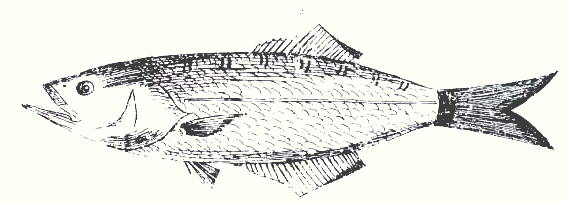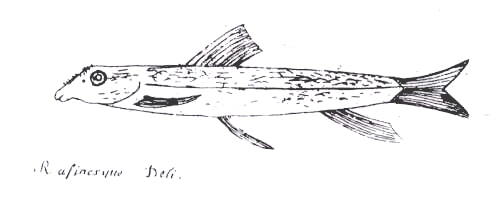
Constantine Samuel Rafinesque rarely included sketches of fish in the publications in which he gave first descriptions. An exception is his article in the first volume of the Journal of the Academy of Natural Sciences of Philadelphia, in 1818. On pages 417-422, Rafinesque introduces genera as indicated by the title, "Description of three new genera of fluviatile Fish, POMOXIS, SARCHIRUS, and EXOGLOSSUM." His sketches of representatives of these genera appear in Plate 17 of the same issue and are reproduced here.

|
In his article, Rafinesque gives the earliest scientific description of the white crappie, under the taxon Pomoxis annularis, thereby establishing the new genus, Pomoxis. Eleven years later, the black crappie, Pomoxis nigromaculatus was credited to Charles-Alexandre Lesueur on the basis of specimens taken from the Wabash River near his home in New Harmony, Indiana. (More on the early literature can be found by searching the Eschmeyer Fish Database, accessible below.)
In introducing the new genus Sarchirus, Rafinesque compares it to Esox (pikes) and Lepisosteus (gars). However, later ichthyologists appear to have concluded that the species in question, which Rafinesque called Sarchirus vittatus, was actually a gar.

|
He writes:
Pectoral fins round, without rays; but with a thin circular membrane surrounding an adipose base... This genus differs from Esox and Lepisosteus by the singular structure of the pectoral fins, from the last besides by having no scales, and from Esox by the shape of the tail. Its appearance is otherwise similar.
With regard to the particular species, Rafinesque continues:
This singular fish inhabits the lower parts of the river Ohio, where I saw it in June; its vulgar names are Gar-fish and Ribbon-fish, the former of which is common to all the species of the genus Lepisosteus. Its length varies from six to twelve inches. It is not used as food, probably through the same prejudice that militates against Gar-fish...
The third genus introduced in Rafinesque's article remains valid today, although Rafinesque was, in this case, nearly preceded by Lesueur in establishing a new genus.

|
In Rafinesque's words,
Mr. Lesueur has described in the Journal of this Academy, a new fish under the name of Cyprinus maxillingua, which he considered as an anomalous species, and he hinted that it might at some future period become the type of a new genus. This proper suggestion is now proved to be correct, by the discovery which I have made of three other species having the same singular character in the lower lip.
Rafinesque continues, "... for the sake of euphony I [choose, as a name] Exoglossum, which means outside tongue, wherein the middle lobe of the lower jaw assumes the appearance of a tongue jutting out of the mouth. This genus may be distinguished at first sight, by this striking character, from any other of the same family."
The sketch above represents Exoglossum maxillingua. This was the species which Lesueur had described on page 85 of the same volume, where he assigned it to the genus Cyprinus. Actually, Rafinesque regarded his specimen to represent a new species (which he named E. annulatum), but subsequent study has shown the species to be that described by Lesueur. Lesueur's specimens were from Pipe Creek in Maryland. Rafinesque writes:
I detected this species in June 1817, in the Fishkill, which falls into the Hudson river above the Highlands: it is very common there, and called Black chub, a name often given to many species in the United States.
Rafinesque's sketch of another species, Exoglossum macropterum, is shown below. "I found it in the Ohio, at the falls [near Louisville, Kentucky], where it is called Stone-toter, in reference to the hard tubercles of its head. It is quite a small fish, from two to three inches long. It is used for bait..." No synonym for E. macropterum is given in the Eschmeyer Catalog of Fishes (link below), and this taxon does not appear in the index of the Atlas of North American Freshwater Fishes.
(In Rafinesque's article, the labels "3" and "4" for the sketches of the species of Exoglossum should be transposed.)

|
Constantine Samuel Rafinesque, naturalist
Catalog of Fishes
New Harmony Scientists, Educators, Writers & Artists
Clark Kimberling Home Page